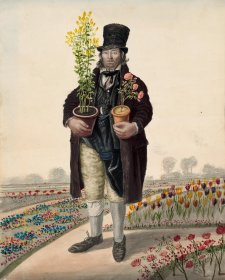The popular image of the blind or disabled young girl selling watercress comes from a slightly later period than Dempsey’s. This Victorian perception of the trade is reflected in a ‘cruelly pathetic’ interview by Henry Mayhew in London labour and the London poor, in sentimental verses by the workingclass poet Thomas Miller, in a painting by Frederick Ifold (1867, private collection) and in the official name of John Groom’s Crippleage — ‘The Watercress and Flower Girls’ Christian Mission’ — a charity that provided hot cocoa, dinner and Bible readings to the waifs of Farringdon Market.
Watercress was not, however, just a Victorian taste, but a more venerable commodity and, despite the small margins, it long had a strong market as a convenient street food. Bought by labourers for breakfast either in a sandwich, or by itself in bunches, it became known as ‘poor man’s bread’. While large-scale cultivation did not begin until early in the 19th century, cress was certainly being sold in the streets of London in the 1770s, as can be inferred from Johan Zoffany’s ‘Fancy Picture’ The watercress girl (c. 1770, private collection). Later images include Thomas Bewick’s wood engraving of the ‘wretched matron, forced in age, for bread, / To strip the brook with mantling cresses spread’, an illustration to Oliver Goldsmith’s enclosure lament, The deserted village, and prints of London cress criers by Thomas Rowlandson (1799), William Marshall Craig (1804) and Thomas Lord Busby (1820).
Here, however, the vendor in his countryman’s smock is not selling a bound bunch to an urban worker, but is dropping a generous handful onto a plate proffered by a mob-capped and aproned kitchen maid. Indeed, the work’s inscription locates the transaction in Salisbury. This is not surprising; the clean, alkaline, mineral-rich chalk streams of Wiltshire and of neighbouring Dorset and Hampshire made those counties important sites of watercress production. Even so, this low-cost trade appears to have been merely a possible rather than a particularly profitable one: witness the big toe sticking out from a hole in the man’s battered right shoe.
Collection: Tasmanian Museum and Art Gallery, presented by C. Docker, 1956



Dempsey’s people: a folio of British street portraits 1824–1844 is the first exhibition to showcase the compelling watercolour images of English street people made by the itinerant English painter John Dempsey throughout the first half of the nineteenth century.



Visit us, learn with us, support us or work with us! Here’s a range of information about planning your visit, our history and more!



We depend on your support to keep creating our programs, exhibitions, publications and building the amazing portrait collection!